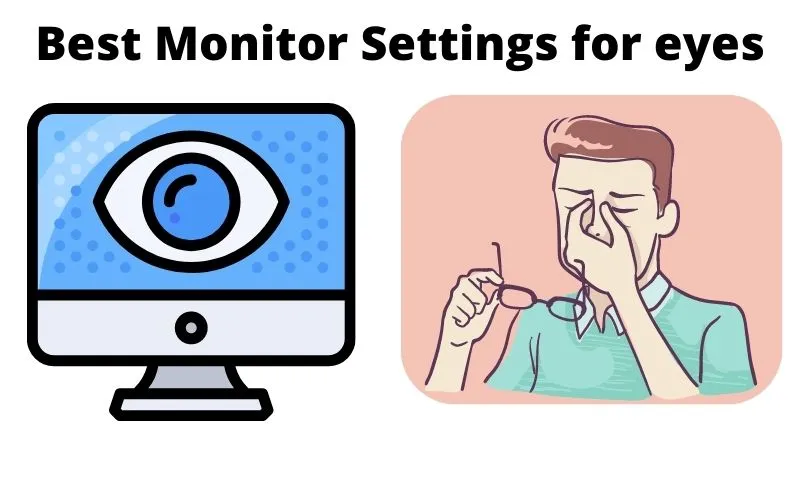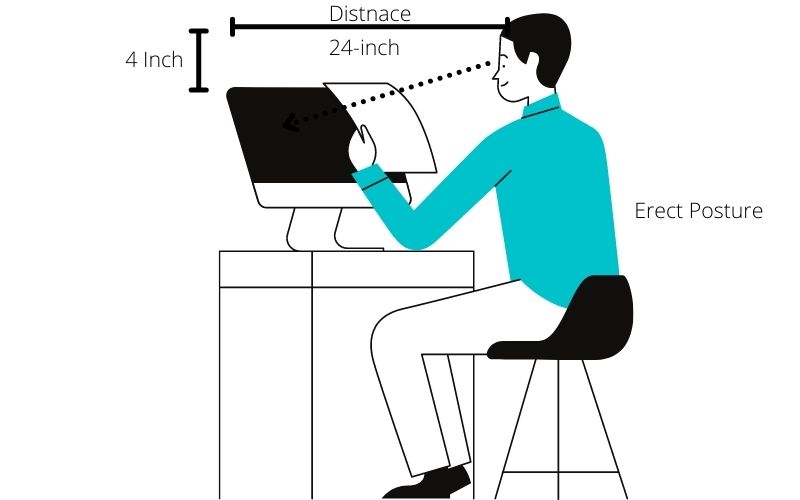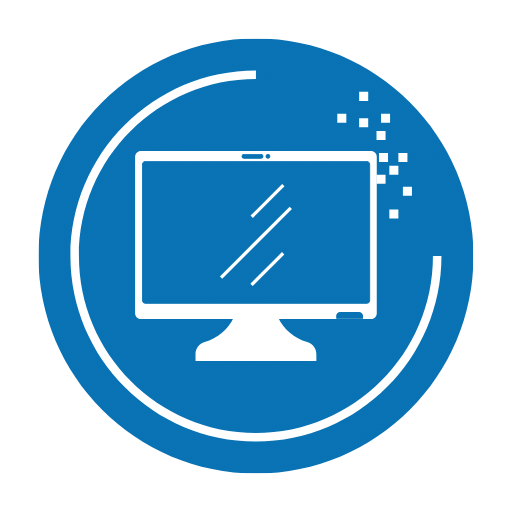Beware! Your monitor setting may be causing eye strain, itching, and blurred vision. While we can’t escape screens altogether, we can reduce eye strain by adopting the best monitor settings for the eyes and other measures. If you are someone who spends most of your time in front of the screen, this article is a must-read.
Being a hardcore gamer and professional coder, I spend most of my time in front of the monitor. And over the years, I have seen health issues with my eyes. This is why I take the matter of eye strain with seriousness.
In medical terms, the effect of screens on the eyes is called Computer Vision syndrome.
Here is the complete guide to best monitor settings for eyes that will reduce eye strain and enhance productivity. This guide is the result of deep research and experience. Most of the recommendations are based on research conducted by prestigious institutions.
Also, check our list of best monitors for eye strain.

- Best Screen Brightness for Eyes
- Best Contrast Setting for Monitor
- Best RGB settings for Eyes: Color Settings
- Best Text size and Fonts
- Ideal Monitor Viewing Distance, Angle & Eye Level
- Best Refresh Rate Setting
- Best Blue Light setting
- Monitor Color Temperature Eye Strain
- Best Screen Resolution for Eyes
- Use Anti Glare Screen
- Extra Tips to reduce eye strain
- Final Words
- FAQs
Best Screen Brightness for Eyes
Many studies have shown that brightness plays a critical role in causing eye strain. If you are looking at a bright screen in a dark room, you are in destruction mode. But if you set your monitor to optimal brightness according to the ambient, you will definitely feel less eye strain.
While there is no single magic number to set your brightness to as it varies from brand to brand and the background lighting. But I can give you the key to unlocking the best screen brightness for the eyes!
The difference in brightness between your workplace and your screen should be as little as possible. If you work in a dark room keep your brightness to a minimum (0) you use some LED lights over the monitor to reduce the difference. This way your eyes will feel less strain. If your workplace has a brightness of around 2500-4500 lux, you should set your monitor brightness to 100-150 cd/m2.
Similarly, in bright surroundings or daylights, you can level up the brightness so you can easily see the screen.
Best Contrast Setting for Monitor
When it comes to the best monitor settings for the eyes, the optimal contrast of the monitor can reduce eye strain. Monitor contrast signifies the ratio of black to white on the screen. Human eyes have been shown to perceive high contrasts with some fatigue. So the best contrast setting for the monitor is a low value (50) at night. But you can also keep it at 60-to 70 depending on your comfort and picture quality.
Best RGB settings for Eyes: Color Settings
RGB stands for the three primary colors red, green, and blue. All other colors emerge when any of these are mixed. While out of the box, the computer monitors are calibrated to 50 for each color. Since blue light is detrimental to the eyes, so the best RGB setting for eyes will reduce blue light. Reduce the blue light till you see a yellowish tint.
Best Text size and Fonts
Fonts and texts are especially important if you are working with lots of numbers on spreadsheets or anywhere. If the text size is small and the font is difficult to read, it will result in eye fatigue, therefore set your size and font in such a way that these are easily readable. Arial font with 12 or larger size is a good option.
Ideal Monitor Viewing Distance, Angle & Eye Level

You need to properly set up your workplace so that the monitor is directly in front of you and not at an angle. This will be easy on your eyes.
According to studies, the distance between you and the monitor should be some 20-40 inches away to reduce eye strain. The closer the monitor to your eyes, the more the eye strain.
The same study also found that if you set your monitor to a height so that eyes are above the monitor level, you will have less eye strain. So, always set your monitor in a way that you should not be looking upward while looking at the monitor. Rather, the monitor screen be 4 to 5 inches low from your eye level recommended American Optometric Association.
Here is the table showing ideas distance for each monitor size and resolution. This table has been prepared with the guidelines of the Society of Motion Picture and Television Engineers (SMPTE) using BenQ monitors.
| Monitor Size | Resolution | Ideal Viewing Distance |
|---|---|---|
| 24 inch | 1080p | 3.2 ft |
| 24 inch | 1440p | 2.3-3.2 ft |
| 24 inch | 4k | 2-3 ft |
| 27 inch | 1080p | 3.4-3.6 ft |
| 27 inch | 1440p | 2.6-3.6 ft |
| 27 inch | 4k | 1.7-3.6 ft |
| 32 inch | 1440p | 3.2-4.3 ft |
| 32 inch | 1440p | 2-4.3 ft |
Best Refresh Rate Setting
Refresh rate is extremely important for eye strain. It has been shown in many studies that lower refresh rates result in noticeable flicker which in turn causes eye strain. If your monitor allows higher refresh rates, it is better to set your refresh rates higher. Monitor rates from 75-to 100 are better than 60 or lower for your eyes.
Best Blue Light setting
Our eyes are especially sensitive to blue light. It has been shown in many studies that blue light of 400-500nm is detrimental to your eyes. Therefore, if your monitor has blue light in this range, you need to adjust the blue light in the setting. If you cannot do this through setting then it is best to wear some glasses or other methods.
Monitor Color Temperature Eye Strain
Color temperature is related to the light emission due to temperature. This is also an important factor for eye strain. Color temperature is measured in the Kelvin. Its range on the monitor is usually 1000-10000. This is also related to blue light. To reduce eye strain you should keep it at 6500 kelvin or low. If you want to eliminate blue light, lower the color temperature till you see a yellowish tint on the screen. Though lower is better image color changes as you lower the value. So, I will suggest you can lower it to an optimal level so that image quality is also not compromised.
Best Screen Resolution for Eyes
When it comes to screen resolutions, the higher the better. So a 4k is better than 2k and 1440p is better than 1080.
Use Anti Glare Screen
It has been shown by many studies that glare causes eye strain. And if you use an anti-glare screen, you will feel less eye strain. So, make sure you are using an anti-glare screen.
Extra Tips to reduce eye strain
20-20-20 Rule
American Optometric Association recommends the 20-20-20 rule for people who spend longer periods of time on their screens. The idea is to take a break of 20 sec every 20 minutes. And during the break, you are advised to stare at an object 20 inches away from you for 20 seconds.
Frequent Blinking
When we are looking at the screens, we often blink less than in normal situations. And this is also part of the problem in the eye strain equations. Therefore, you should make a conscious effort of frequent blinking while working with a monitor or any display device.
Reference Material Location
When you are typing certain things from reference material, you have to look at three different positions. You need to look at the reference material, keyboard, and monitor screen. In that situation, it is better to keep the notes in line with the monitor and keyboard, so your head does not need to turn repeatedly.
Use of Software and Apps
Luckily, many software programs are available that can set your monitor to eye-friendly mode. Similarly, you can use some applications for your phone as well. For monitors, F.lux and Iris are the two widely used and trusted software solutions. They automatically adjust the brightness, contrast, colors, and blue light to a safe level.
Final Words
If you calibrate your device to the best monitor setting for your eyes, you can save your eyes from the adverse effects of the monitor. Since it is almost impossible to avoid screens, we are only left with the best brightness and contrast settings and other measures to reduce eye strain.
FAQs
Is low brightness bad for your eyes?
It is not just about low brightness and high brightness. It is about the relative brightness of the surroundings and the monitor. In daylight, if your monitor brightness is low, it will cause eye strain. But at night, low brightness will be beneficial.
Does lowering brightness help the eyes?
Yes, if you are in a dark room or in a low brightness place, lowering brightness helps the eyes.
Is a brighter screen better for the eyes?
No, brighter screens are not better for eyes in the dark surrounding. But they are better for daylight and highlight work areas.

